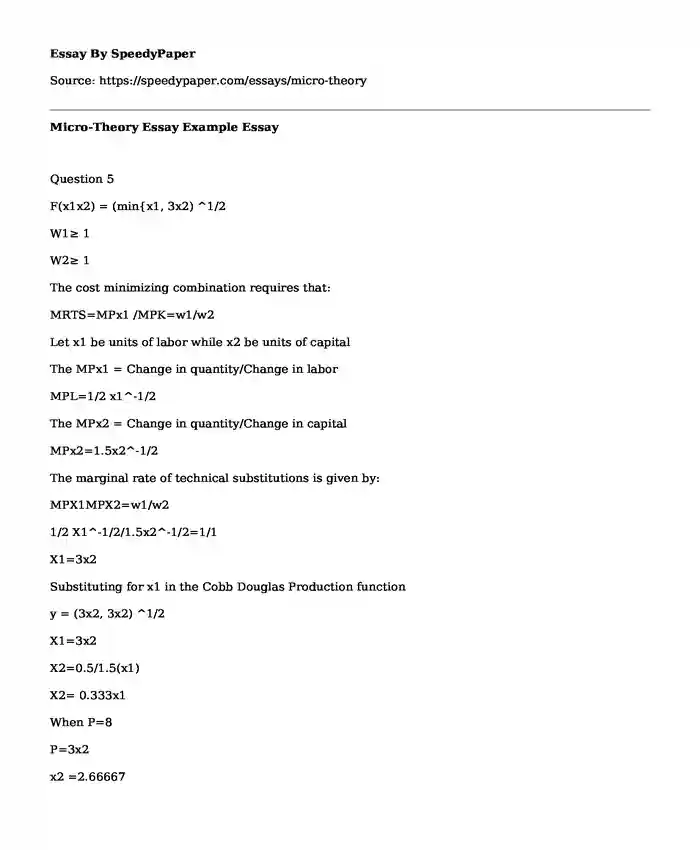Question 5
F(x1x2) = (min{x1, 3x2) ^1/2
W1≥ 1
W2≥ 1
The cost minimizing combination requires that:
MRTS=MPx1 /MPK=w1/w2
Let x1 be units of labor while x2 be units of capital
The MPx1 = Change in quantity/Change in labor
MPL=1/2 x1^-1/2
The MPx2 = Change in quantity/Change in capital
MPx2=1.5x2^-1/2
The marginal rate of technical substitutions is given by:
MPX1MPX2=w1/w2
1/2 X1^-1/2/1.5x2^-1/2=1/1
X1=3x2
Substituting for x1 in the Cobb Douglas Production function
y = (3x2, 3x2) ^1/2
X1=3x2
X2=0.5/1.5(x1)
X2= 0.333x1
When P=8
P=3x2
x2 =2.66667
X1=1.666
X2=0.333x1
X2= (0.333*1.666)
X2=0.5444
Q = (1.666, 3{0.5444}) ^1/2
Q= (2.7216)1/2
Q*=1.65 Units
Question 6
Question 6a
The long run formula will be :
Q(x1, x2)=min(x1,x2)^1/2
In the short run, the labor which is greater than 16 has no effect on the level of out put.
The short run production function is given by:
Y=
Y= 4 Therefore, L>4 or L≤ 4
The formula for the marginal product of labor
MPL= (4L)^-1/2 :L>4 or L≤ 4
Question 6b
When w=1 and price =$ 4
The labor demand which is optimal=PMPL=w
It thus means 4*(1/2(L)^1/2=1
2/(L)^1/2=1
(L^1/2)^2=(2)^2
L=4
Question 6c
When w=1 and price =$ 10
The labor demand which is optimal=PMPL=w
It thus means 4*(1/2(L)^1/2=1
5/(L)^1/2=1
(L^1/2)^2= (5)^2
L=25 Units
Question 6d
The equilibrium demand for labor PMPL=w
And in this situation w=p/2(L) ^1/2
Therefore, the equation can be written as:
L=min {(p/2w) ^2, 4}
Question 7
Question 7a
Total cost function=c=y^2+10 for y>0 and c=0
MR=MC
MC=First derivative of cost function
MC=MR=2y
The average cost= TC/Q
= (y^2+10)/y
= y + (10/y)
Question 7b
The minimum average cost
Av=(y^2+10)/y
First order derivatives
AV’=y+(10/y)
1+10/y
The minimum of MC
MC’=2y
But at Minimums MC=AV
1+10/y=2y
Y+10=2y2
2y2-y-10=0
y(2y-1)=10
y=10
0r
2y-1=10 Units
Y= 4.5 units
The quantity at which the quantity is minimized in the long run
The first derivative equated to 0
MC=MR=2y=0
Y=0/2= ∞
Hence the minimum is absolute minimum quantity.
Question 7c
MC=2y=MR
The variable cost= y2
Average variable cost= y2/y
=y which is minimized at y=0
Marginal function is given as
First derivative
oVC/dy=2y
P=2y which is the supply curve
At the quantity of 4.5
P= (2*4.5)
P = 9 Units
At the quantity of 10
P=2*(10)
P=20 Units
Therefore, the minimum price in which they can produce a positive quantity is 9 Units
Question 8
Question 8a
Given that s1(p) = p, s2(p) = 2p, s3(p) = 3p.
Then the market supply function is given as
S(P)= (S1+S2+S3)P
=S(p)=( p+2p+3p)
S(p)=6p
Question 8b
Given that s1(p) = 2p, s2(p) = p – 1
Then the market supply function is given as:
S(P)= (S1+S2)P
S(P)= (p – 1)+2p
S(P)=3P-1
Question 8c
200 firms each having a supply function of s1 (p) = 2p – 8 and other 100 firms having a supply function of s2 (p) = p – 3
The first 200 firms supply function
S1(p)=200(2p-8)
S(p)=400p-1600 …..1
The 2nd 200 firms supply function
The supply function = s2(p) = p – 3
(s(p) =100( p – 3)
(s(p)=100p-300………2
Total supply for the market is the summation of equation 1 and 2
Market’s s(p)= {400p-1600} +{100p-300}
s(p)= 500p-1900
s(p)=5p-19
Cite this page
Micro-Theory Essay Example. (2017, Nov 28). Retrieved from https://speedypaper.com/essays/micro-theory
Request Removal
If you are the original author of this essay and no longer wish to have it published on the SpeedyPaper website, please click below to request its removal:
- Free Essay on Short Term Versus Long Term Pricing Decisions for Business
- The Baptist Faith, Essay Example in Religion
- Free Essay Sample on the Therapeutic Oxygen Kit in the Air France Airline
- Mohammed Ali Research in the Free Essay Sample
- Hospital Policy: Facility Management. Free Essay Sample for Students.
- Speech Paper Sample: Why We Should Go to College
- Essay Sample on Waiting for Superman Movie
Popular categories





